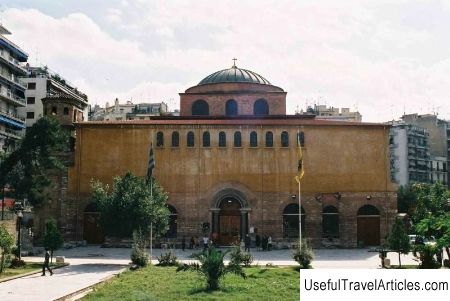Agia Sofia description and photos - Greece: Thessaloniki
Rating: 7,6/10 (304 votes) 
Agia Sofia description and photos - Greece: Thessaloniki. Detailed information about the attraction. Description, photographs and a map showing the nearest significant objects. The title in English is Agia Sofia. Photo and descriptionThe Hagia Sophia, or Hagia Sophia, is one of the oldest Christian churches in the Greek city of Thessaloniki (under the jurisdiction of the Metropolitanate of Thessaloniki.). The cathedral is located in the historic center of the city on the square of the same name and is rightfully considered one of its most interesting sights, as well as an important historical and architectural monument. Hagia Sophia was built on the site of the destroyed at the beginning of the 7th century early Christian basilica, which was part of a huge religious complex. The exact date of the construction of the temple is not known for certain, but most historians agree that the cathedral was erected in the late 7th - early 8th centuries. The very first written records of Hagia Sophia in Thessaloniki date back to the end of the 8th century. In 1430, Thessaloniki became part of the Ottoman Empire, but Hagia Sophia remained a Christian temple until 1523, after which it suffered the fate of most Christian shrines on the territory of modern Greece - the famous cathedral turned into a mosque. The facade of the cathedral was decorated with a traditional Turkish portico, and the bell tower became a minaret (a little later, another minaret was added). In 1890, the building of the cathedral was severely damaged by fire. Partially repair work was carried out by the Turks, while the main work began after Thessaloniki was liberated and the cathedral was returned to Christians. At the same time, the minarets were removed, and the elegant Turkish portico was destroyed during the Italian bombing in 1941. The dome was restored only in 1980. In 1988, among other early Christian and Byzantine monuments of Thessaloniki, Hagia Sophia was included in the UNESCO World Heritage List. Hagia Sophia is a beautiful and rather rare example of a Byzantine temple that combines elements of a three-nave basilica and a cross-domed church. Of particular interest are the magnificent ancient mosaics (including those of the iconoclastic period in the form of crosses, stars, and liturgical texts) and frescoes (11th century) that adorn the interior of the cathedral and are perfectly preserved to this day largely due to the fact that during the Ottoman period domination was hidden under a thick layer of plaster.    We also recommend reading Ruins of the Hisarlik fortress description and photos - Bulgaria: Kyustendil Topic: Agia Sofia description and photos - Greece: Thessaloniki. |




